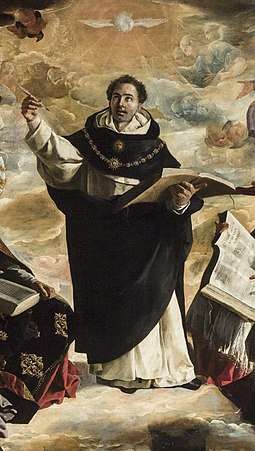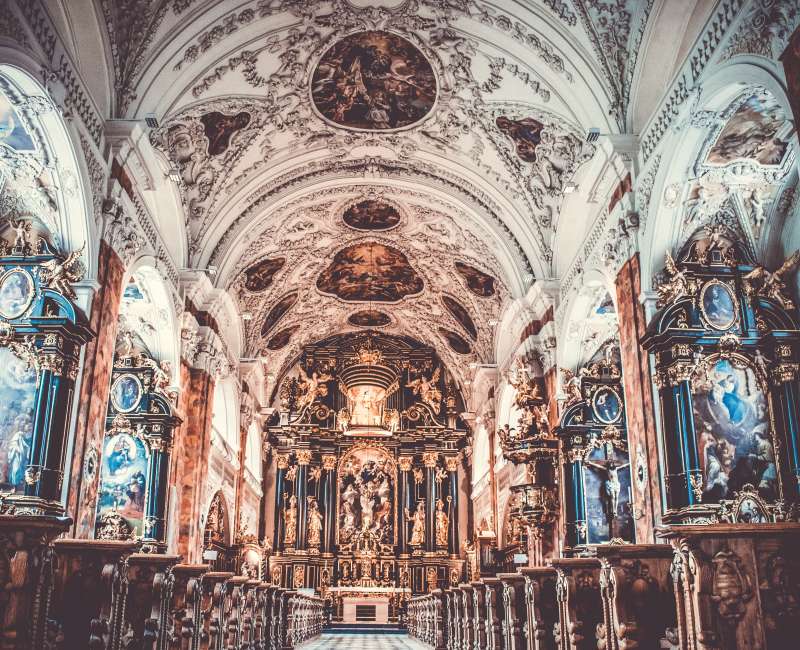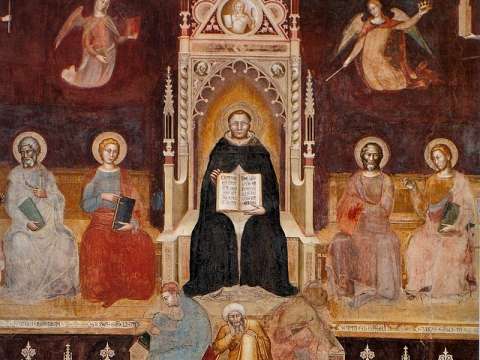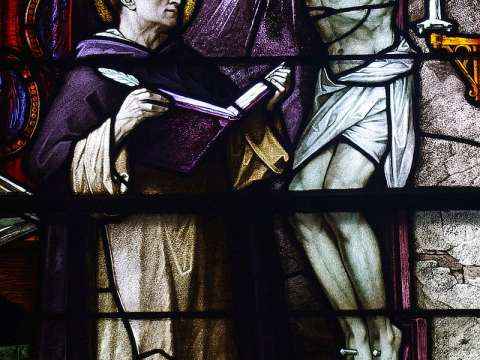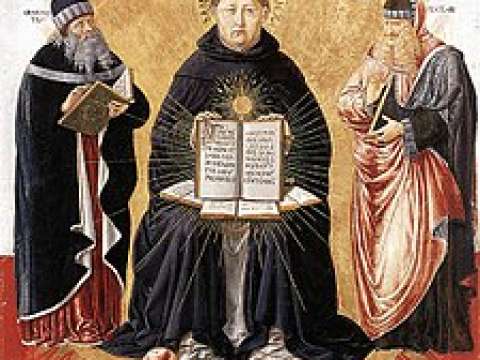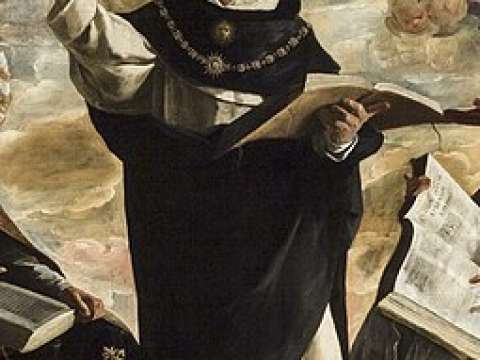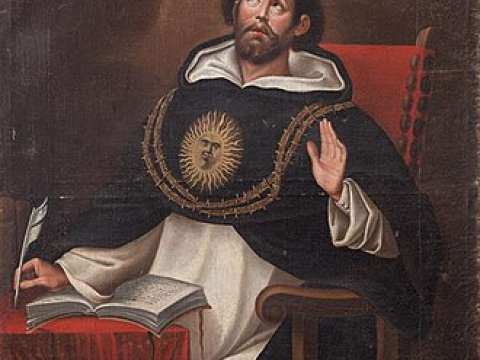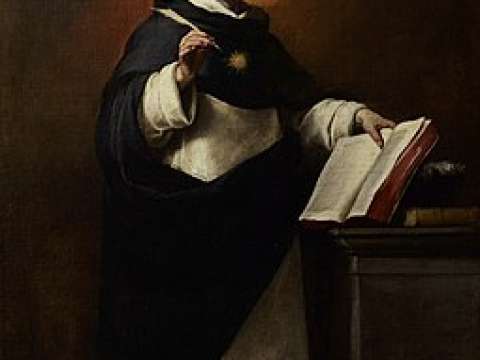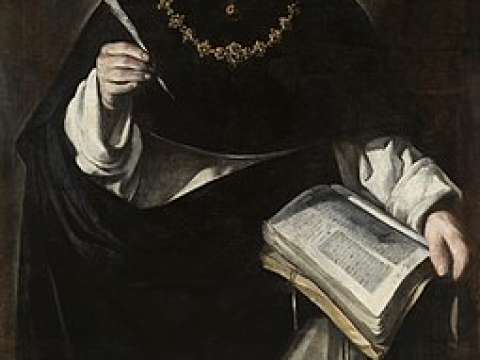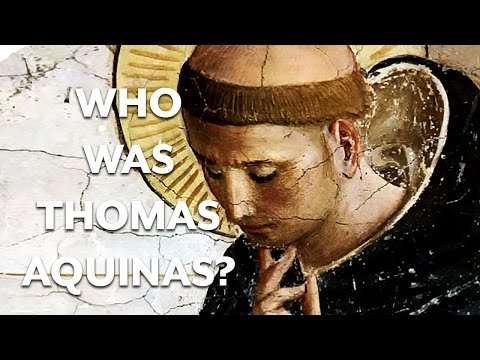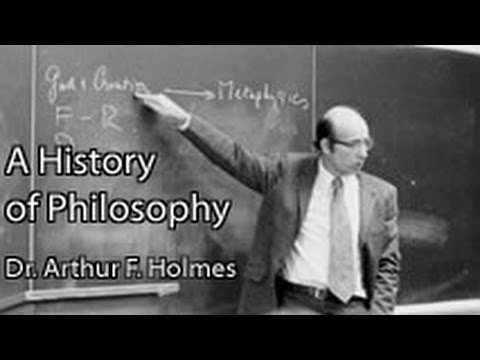

Thomas Aquinas (1225-1274)
To one who has faith, no explanation is necessary. To one without faith, no explanation is possible.
Thomas Aquinas was an Italian Dominican friar, philosopher, Catholic priest, and Doctor of the Church. An immensely influential philosopher, theologian, and jurist in the tradition of scholasticism, he is also known within the latter as the Doctor Angelicus and the Doctor Communis. The name Aquinas identifies his ancestral origins in the county of Aquino in present-day Lazio, Italy. He was the foremost classical proponent of natural theology and the father of Thomism; of which he argued that reason is found in God. His influence on Western thought is considerable, and much of modern philosophy developed or opposed his ideas, particularly in the areas of ethics, natural law, metaphysics, and political theory.
Unlike many currents in the Church of the time, Thomas embraced several ideas put forward by Aristotle—whom he called "the Philosopher"—and attempted to synthesize Aristotelian philosophy with the principles of Christianity.
His best-known works are the Disputed Questions on Truth 1256–1259, the Summa contra Gentiles 1259–1265, and the unfinished but massively influential Summa Theologica a.k.a. Summa Theologiae 1265–1274. His commentaries on Scripture and on Aristotle also form an important part of his body of work. Furthermore, Thomas is distinguished for his eucharistic hymns, which form a part of the Church's liturgy. The Catholic Church honors Thomas Aquinas as a saint and regards him as the model teacher for those studying for the priesthood, and indeed the highest expression of both natural reason and speculative theology. In modern times, under papal directives, the study of his works was long used as a core of the required program of study for those seeking ordination as priests or deacons, as well as for those in religious formation and for other students of the sacred disciplines philosophy, Catholic theology, church history, liturgy, and canon law.
Thomas Aquinas is considered one of the Catholic Church's greatest theologians and philosophers. Pope Benedict XV declared: "This Dominican Order ... acquired new luster when the Church declared the teaching of Thomas to be her own and that Doctor, honored with the special praises of the Pontiffs, the master and patron of Catholic schools." The English philosopher Anthony Kenny considers Thomas to be "one of the dozen greatest philosophers of the western world".
Biography
Early life 1225–1244
Thomas was most likely born in the castle of Roccasecca, Aquino, controlled at that time by the Kingdom of Sicily in present-day Lazio, Italy, c. 1225, According to some authors, he was born in the castle of his father, Landulf of Aquino. He was born to the most powerful branch of the family, and Landulf of Aquino was a man of means. As a knight in the service of King Roger II, he held the title miles. Thomas's mother, Theodora, belonged to the Rossi branch of the Neapolitan Caracciolo family. Landulf's brother Sinibald was abbot of Monte Cassino, the oldest Benedictine monastery. While the rest of the family's sons pursued military careers, the family intended for Thomas to follow his uncle into the abbacy; this would have been a normal career path for a younger son of southern Italian nobility.
At the age of five Thomas began his early education at Monte Cassino but after the military conflict between the Emperor Frederick II and Pope Gregory IX spilled into the abbey in early 1239, Landulf and Theodora had Thomas enrolled at the studium generale university recently established by Frederick in Naples. It was here that Thomas was probably introduced to Aristotle, Averroes and Maimonides, all of whom would influence his theological philosophy. It was also during his study at Naples that Thomas came under the influence of John of St. Julian, a Dominican preacher in Naples, who was part of the active effort by the Dominican order to recruit devout followers. There his teacher in arithmetic, geometry, astronomy, and music was Petrus de Ibernia.
At the age of nineteen Thomas resolved to join the recently founded Dominican Order. Thomas's change of heart did not please his family. In an attempt to prevent Theodora's interference in Thomas's choice, the Dominicans arranged to move Thomas to Rome, and from Rome, to Paris. However, while on his journey to Rome, per Theodora's instructions, his brothers seized him as he was drinking from a spring and took him back to his parents at the castle of Monte San Giovanni Campano.

Thomas was held prisoner for almost one year in the family castles at Monte San Giovanni and Roccasecca in an attempt to prevent him from assuming the Dominican habit and to push him into renouncing his new aspiration. Political concerns prevented the Pope from ordering Thomas's release, which had the effect of extending Thomas's detention. Thomas passed this time of trial tutoring his sisters and communicating with members of the Dominican Order. Family members became desperate to dissuade Thomas, who remained determined to join the Dominicans. At one point, two of his brothers resorted to the measure of hiring a prostitute to seduce him. According to legend, Thomas drove her away wielding a fire iron and two angels appeared to him as he slept and strengthened his determination to remain celibate.
By 1244, seeing that all her attempts to dissuade Thomas had failed, Theodora sought to save the family's dignity, arranging for Thomas to escape at night through his window. In her mind, a secret escape from detention was less damaging than an open surrender to the Dominicans. Thomas was sent first to Naples and then to Rome to meet Johannes von Wildeshausen, the Master General of the Dominican Order.
Paris, Cologne, Albert Magnus, and first Paris regency 1245–1259
In 1245 Thomas was sent to study at the Faculty of the Arts at the University of Paris, where he most likely met Dominican scholar Albertus Magnus, then the holder of the Chair of Theology at the College of St. James in Paris. When Albertus was sent by his superiors to teach at the new studium generale at Cologne in 1248, Thomas followed him, declining Pope Innocent IV's offer to appoint him abbot of Monte Cassino as a Dominican. Albertus then appointed the reluctant Thomas magister studentium. Because Thomas was quiet and didn't speak much, some of his fellow students thought he was slow. But Albertus prophetically exclaimed: "You call him the dumb ox, but in his teaching he will one day produce such a bellowing that it will be heard throughout the world."
Thomas taught in Cologne as an apprentice professor baccalaureus biblicus, instructing students on the books of the Old Testament and writing Expositio super Isaiam ad litteram Literal Commentary on Isaiah, Postilla super Ieremiam Commentary on Jeremiah and Postilla super Threnos Commentary on Lamentations. Then in 1252 he returned to Paris to study for the master's degree in theology. He lectured on the Bible as an apprentice professor, and upon becoming a baccalaureus Sententiarum bachelor of the Sentences he devoted his final three years of study to commenting on Peter Lombard's Sentences. In the first of his four theological syntheses, Thomas composed a massive commentary on the Sentences titled Scriptum super libros Sententiarium Commentary on the Sentences. Aside from his master's writings, he wrote De ente et essentia On Being and Essence for his fellow Dominicans in Paris.

In the spring of 1256 Thomas was appointed regent master in theology at Paris and one of his first works upon assuming this office was Contra impugnantes Dei cultum et religionem Against Those Who Assail the Worship of God and Religion, defending the mendicant orders, which had come under attack by William of Saint-Amour. During his tenure from 1256 to 1259, Thomas wrote numerous works, including: Questiones disputatae de veritate Disputed Questions on Truth, a collection of twenty-nine disputed questions on aspects of faith and the human condition prepared for the public university debates he presided over on Lent and Advent; Quaestiones quodlibetales Quodlibetal Questions, a collection of his responses to questions posed to him by the academic audience; and both Expositio super librum Boethii De trinitate Commentary on Boethius's De trinitate and Expositio super librum Boethii De hebdomadibus Commentary on Boethius's De hebdomadibus, commentaries on the works of 6th-century Roman philosopher Boethius. By the end of his regency, Thomas was working on one of his most famous works, Summa contra Gentiles.
Naples, Orvieto, Rome 1259–1268
In 1259 Thomas completed his first regency at the studium generale and left Paris so that others in his order could gain this teaching experience. He returned to Naples where he was appointed as general preacher by the provincial chapter of 29 September 1260. In September 1261 he was called to Orvieto as conventual lector he was responsible for the pastoral formation of the friars unable to attend a studium generale. In Orvieto Thomas completed his Summa contra Gentiles, wrote the Catena aurea The Golden Chain, and produced works for Pope Urban IV such as the liturgy for the newly created feast of Corpus Christi and the Contra errores graecorum Against the Errors of the Greeks. Some of the hymns that Thomas wrote for the feast of Corpus Christi are still sung today, such as the Pange lingua whose penultimate verse is the famous Tantum ergo, and Panis angelicus. Modern scholarship has confirmed that Thomas was indeed the author of these texts, a point that some had contested.
In February 1265 the newly elected Pope Clement IV summoned Thomas to Rome to serve as papal theologian. This same year he was ordered by the Dominican Chapter of Agnani to teach at the studium conventuale at the Roman convent of Santa Sabina, founded some years before, in 1222. The studium at Santa Sabina now became an experiment for the Dominicans, the Order's first studium provinciale, an intermediate school between the studium conventuale and the studium generale. Prior to this time the Roman Province had offered no specialized education of any sort, no arts, no philosophy; only simple convent schools, with their basic courses in theology for resident friars, were functioning in Tuscany and the meridionale during the first several decades of the order's life. The new studium provinciale at Santa Sabina was to be a more advanced school for the province. Tolomeo da Lucca, an associate and early biographer of Thomas, tells us that at the Santa Sabina studium Thomas taught the full range of philosophical subjects, both moral and natural.

While at the Santa Sabina studium provinciale Thomas began his most famous work, the Summa theologiae, which he conceived specifically suited to beginning students: "Because a doctor of Catholic truth ought not only to teach the proficient, but to him pertains also to instruct beginners. As the Apostle says in 1 Corinthians 3:1–2, as to infants in Christ, I gave you milk to drink, not meat, our proposed intention in this work is to convey those things that pertain to the Christian religion in a way that is fitting to the instruction of beginners." While there he also wrote a variety of other works like his unfinished Compendium Theologiae and Responsio ad fr. Ioannem Vercellensem de articulis 108 sumptis ex opere Petri de Tarentasia Reply to Brother John of Vercelli Regarding 108 Articles Drawn from the Work of Peter of Tarentaise. In his position as head of the studium Thomas conducted a series of important disputations on the power of God, which he compiled into his De potentia. Nicholas Brunacci was among Thomas's students at the Santa Sabina studium provinciale and later at the Paris studium generale. In November 1268 he was with Thomas and his associate and secretary Reginald of Piperno, as they left Viterbo on their way to Paris to begin the academic year. Another student of Thomas's at the Santa Sabina studium provinciale was Blessed Tommasello da Perugia.
Thomas remained at the studium at Santa Sabina from 1265 until he was called back to Paris in 1268 for a second teaching regency. With his departure for Paris in 1268 and the passage of time the pedagogical activities of the studium provinciale at Santa Sabina were divided between two campuses. A new convent of the Order at the Church of Santa Maria sopra Minerva had a modest beginning in 1255 as a community for women converts, but grew rapidly in size and importance after being given over to the Dominicans friars in 1275. In 1288 the theology component of the provincial curriculum for the education of the friars was relocated from the Santa Sabina studium provinciale to the studium conventuale at Santa Maria sopra Minerva, which was redesignated as a studium particularis theologiae. This studium was transformed in the 16th century into the College of Saint Thomas Latin: Collegium Divi Thomæ. In the 20th century the college was relocated to the convent of Saints Dominic and Sixtus and was transformed into the Pontifical University of Saint Thomas Aquinas, Angelicum.
Quarrelsome second Paris regency 1269–1272
In 1268 the Dominican order assigned Thomas to be regent master at the University of Paris for a second time, a position he held until the spring of 1272. Part of the reason for this sudden reassignment appears to have arisen from the rise of "Averroism" or "radical Aristotelianism" in the universities. In response to these perceived errors, Thomas wrote two works, one of them being De unitate intellectus, contra Averroistas On the Unity of Intellect, against the Averroists in which he reprimands Averroism as incompatible with Christian doctrine. During his second regency, he finished the second part of the Summa and wrote De virtutibus and De aeternitate mundi, contra murmurantes On the Eternity of the World, against Grumblers, the latter of which dealt with controversial Averroist and Aristotelian beginninglessness of the world.
Disputes with some important Franciscans conspired to make his second regency much more difficult and troubled than the first. A year before Thomas re-assumed the regency at the 1266–67 Paris disputations, Franciscan master William of Baglione accused Thomas of encouraging Averroists, most likely counting him as one of the "blind leaders of the blind". Eleonore Stump says, "It has also been persuasively argued that Aquinas's De aeternitate mundi was directed in particular against his Franciscan colleague in theology, John Pecham."

In reality, Thomas was deeply disturbed by the spread of Averroism and was angered when he discovered Siger of Brabant teaching Averroistic interpretations of Aristotle to Parisian students. On 10 December 1270, the Bishop of Paris, Étienne Tempier, issued an edict condemning thirteen Aristotelian and Averroistic propositions as heretical and excommunicating anyone who continued to support them. Many in the ecclesiastical community, the so-called Augustinians, were fearful that this introduction of Aristotelianism and the more extreme Averroism might somehow contaminate the purity of the Christian faith. In what appears to be an attempt to counteract the growing fear of Aristotelian thought, Thomas conducted a series of disputations between 1270 and 1272: De virtutibus in communi On Virtues in General, De virtutibus cardinalibus On Cardinal Virtues, De spe On Hope.
Final days and "straw" 1272–1274
In 1272 Thomas took leave from the University of Paris when the Dominicans from his home province called upon him to establish a studium generale wherever he liked and staff it as he pleased. He chose to establish the institution in Naples, and moved there to take his post as regent master. He took his time at Naples to work on the third part of the Summa while giving lectures on various religious topics. He also preached to the people of Naples every day in Lent, 1273. These sermons on the Commandments, the Creed, the Our Father, and Hail Mary were very popular.
It is traditionally held that on one occasion, in 1273 at the Dominican convent of Naples in the chapel of Saint Nicholas, after Matins, Thomas lingered and was seen by the sacristan Domenic of Caserta to be levitating in prayer with tears before an icon of the crucified Christ. Christ said to Thomas, "You have written well of me, Thomas. What reward would you have for your labor?" Thomas responded, "Nothing but you, Lord." After this exchange something happened, but Thomas never spoke of it or wrote it down.

On 6 December 1273, another mystical experience took place. While he was celebrating Mass, he experienced an unusually long ecstasy. Because of what he saw, he abandoned his routine and refused to dictate to his socius Reginald of Piperno. When Reginald begged him to get back to work, Thomas replied: "Reginald, I cannot, because all that I have written seems like straw to me" mihi videtur ut palea. As a result, the Summa Theologica would remain uncompleted. What exactly triggered Thomas's change in behavior is believed by Catholics to have been some kind of supernatural experience of God. After taking to his bed, he did recover some strength but died three months later.
In 1054 the Great Schism had occurred between the Latin Church following the Pope known as the Roman Catholic Church in the West, and the Patriarchate of Constantinople in the East known as the Eastern Orthodox Church. Looking to find a way to reunite the Eastern Orthodox Church and the Roman Catholic Church, Pope Gregory X convened the Second Council of Lyon to be held on 1 May 1274 and summoned Thomas to attend. At the meeting, Thomas's work for Pope Urban IV concerning the Greeks, Contra errores graecorum, was to be presented.
On his way to the council, riding on a donkey along the Appian Way, he struck his head on the branch of a fallen tree and became seriously ill again. He was then quickly escorted to Monte Cassino to convalesce. After resting for a while, he set out again, but stopped at the Cistercian Fossanova Abbey after again falling ill. The monks nursed him for several days, and as he received his last rites he prayed: "I have written and taught much about this very holy Body, and about the other sacraments in the faith of Christ, and about the Holy Roman Church, to whose correction I expose and submit everything I have written." He died on 7 March 1274 while giving commentary on the Song of Songs.
Claims of levitation
For centuries, there have been recurring claims that Thomas had the ability to levitate. For example, G. K. Chesterton wrote that, "His experiences included well-attested cases of levitation in ecstasy; and the Blessed Virgin appeared to him, comforting him with the welcome news that he would never be a Bishop."
Condemnation of 1277
In 1277 Étienne Tempier, the same bishop of Paris who had issued the condemnation of 1270, issued another more extensive condemnation. One aim of this condemnation was to clarify that God's absolute power transcended any principles of logic that Aristotle or Averroes might place on it. More specifically, it contained a list of 219 propositions that the bishop had determined to violate the omnipotence of God, and included in this list were twenty Thomistic propositions. Their inclusion badly damaged Thomas's reputation for many years.
In the Divine Comedy, Dante sees the glorified soul of Thomas in the Heaven of the Sun with the other great exemplars of religious wisdom. Dante asserts that Thomas died by poisoning, on the order of Charles of Anjou; Villani cites this belief, and the Anonimo Fiorentino describes the crime and its motive. But the historian Ludovico Antonio Muratori reproduces the account made by one of Thomas's friends, and this version of the story gives no hint of foul play.
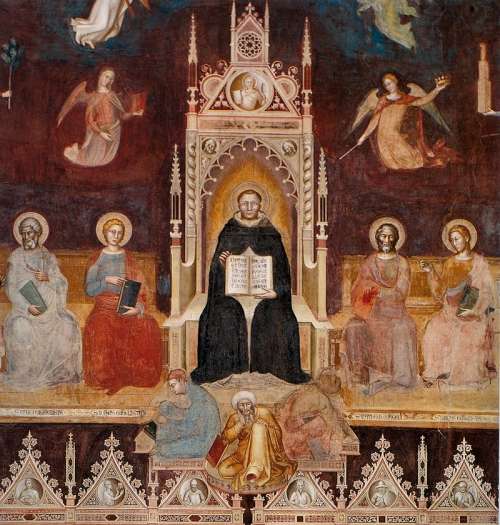
Thomas's theology had begun its rise to prestige. Two centuries later, in 1567, Pope Pius V proclaimed St. Thomas Aquinas a Doctor of the Church and ranked his feast with those of the four great Latin fathers: Ambrose, Augustine of Hippo, Jerome and Gregory. At the Council of Trent, Thomas had the honor of having his Summa theologiae placed on the altar alongside the Bible and the Decretals.
In his encyclical of 4 August 1879, Aeterni Patris, Pope Leo XIII stated that Thomas Aquinas's theology was a definitive exposition of Catholic doctrine. Thus, he directed the clergy to take the teachings of Thomas as the basis of their theological positions. Leo XIII also decreed that all Catholic seminaries and universities must teach Thomas's doctrines, and where Thomas did not speak on a topic, the teachers were "urged to teach conclusions that were reconcilable with his thinking." In 1880, Saint Thomas Aquinas was declared patron of all Catholic educational establishments.
Canonization
When the devil's advocate at his canonization process objected that there were no miracles, one of the cardinals answered, "Tot miraculis, quot articulis"—"there are as many miracles in his life as articles in his Summa". Fifty years after Thomas's death, on 18 July 1323, Pope John XXII, seated in Avignon, pronounced Thomas a saint.
A monastery at Naples, near the cathedral of St. Januarius, shows a cell in which he supposedly lived. His remains were placed in the Church of the Jacobins in Toulouse on 28 January 1369. Between 1789 and 1974, they were held in the Basilique de Saint-Sernin, Toulouse. In 1974, they were returned to the Church of the Jacobins, where they have remained ever since.

When he was canonized, his feast day was inserted in the General Roman Calendar for celebration on 7 March, the day of his death. Since this date commonly falls within Lent, the 1969 revision of the calendar moved his memorial to 28 January, the date of the translation of his relics to Church of the Jacobins, Toulouse.
Thomas Aquinas is honored with a feast day in some churches of the Anglican Communion.
Philosophy
Thomas Aquinas was a theologian and a Scholastic philosopher. However, he never considered himself a philosopher, and criticized philosophers, whom he saw as pagans, for always "falling short of the true and proper wisdom to be found in Christian revelation." With this in mind, Thomas did have respect for Aristotle, so much so that in the Summa, he often cites Aristotle simply as "the Philosopher", a designation frequently used at that time. Much of his work bears upon philosophical topics, and in this sense may be characterized as philosophical. Thomas's philosophical thought has exerted enormous influence on subsequent Christian theology, especially that of the Catholic Church, extending to Western philosophy in general. Thomas stands as a vehicle and modifier of Aristotelianism and Neoplatonism. It is said that Thomas modified both Aristotelianism and Neoplatonism by way of heavy reliance on the Pseudo-Dionysius.
Commentaries on Aristotle
Thomas Aquinas wrote several important commentaries on Aristotle's works, including On the Soul, On Interpretation, Nicomachean Ethics and Metaphysics. His work is associated with William of Moerbeke's translations of Aristotle from Greek into Latin.
Epistemology
Thomas Aquinas believed "that for the knowledge of any truth whatsoever man needs divine help, that the intellect may be moved by God to its act." However, he believed that human beings have the natural capacity to know many things without special divine revelation, even though such revelation occurs from time to time, "especially in regard to such truths as pertain to faith." But this is the light that is given to man by God according to man's nature: "Now every form bestowed on created things by God has power for a determined act, which it can bring about in proportion to its own proper endowment; and beyond which it is powerless, except by a superadded form, as water can only heat when heated by the fire. And thus the human understanding has a form, viz. intelligible light, which of itself is sufficient for knowing certain intelligible things, viz. those we can come to know through the senses."
For example, "Aquinas never compromised Christian doctrine by bringing it into line with current Aristotelianism; rather, he modified and corrected the latter whenever it clashed with Christian belief."
Ethics
Thomas's ethics are based on the concept of "first principles of action". In his Summa theologiae, he wrote:
Virtue denotes a certain perfection of a power. Now a thing's perfection is considered chiefly in regard to its end. But the end of power is act. Wherefore power is said to be perfect, according as it is determinate to its act.
Thomas emphasized that "Synderesis is said to be the law of our mind, because it is a habit containing the precepts of the natural law, which are the first principles of human actions."
According to Thomas "... all acts of virtue are prescribed by the natural law: since each one's reason naturally dictates to him to act virtuously. But if we speak of virtuous acts, considered in themselves, i.e., in their proper species, thus not all virtuous acts are prescribed by the natural law: for many things are done virtuously, to which nature does not incline at first; but that, through the inquiry of reason, have been found by men to be conducive to well living." Therefore, we must determine if we are speaking of virtuous acts as under the aspect of virtuous or as an act in its species.
Thomas defined the four cardinal virtues as prudence, temperance, justice, and fortitude. The cardinal virtues are natural and revealed in nature, and they are binding on everyone. There are, however, three theological virtues: faith, hope, and charity. Thomas also describes the virtues as imperfect incomplete and perfect complete virtues. A perfect virtue is any virtue with charity, charity completes a cardinal virtue. A non-Christian can display courage, but it would be courage with temperance. A Christian would display courage with charity. These are somewhat supernatural and are distinct from other virtues in their object, namely, God:
Now the object of the theological virtues is God Himself, Who is the last end of all, as surpassing the knowledge of our reason. On the other hand, the object of the intellectual and moral virtues is something comprehensible to human reason. Wherefore the theological virtues are specifically distinct from the moral and intellectual virtues.
Thomas Aquinas wrote " is a sin against God, just as all mortal sins, in as much as man condemns things eternal for the sake of temporal things."
Furthermore, in his Treatise on Law, Thomas distinguished four kinds of law: eternal, natural, human, and divine. Eternal law is the decree of God that governs all creation: "That Law which is the Supreme Reason cannot be understood to be otherwise than unchangeable and eternal." Natural law is the human "participation" in the eternal law and is discovered by reason. Natural law is based on "first principles":
. . . this is the first precept of the law, that good is to be done and promoted, and evil is to be avoided. All other precepts of the natural law are based on this . . .
Whether the natural law contains several precepts, or one only is explained by Thomas, "All the inclinations of any parts whatsoever of human nature, e.g., of the concupiscible and irascible parts, in so far as they are ruled by reason, belong to the natural law, and are reduced to one first precept, as stated above: so that the precepts of the natural law are many in themselves, but are based on one common foundation."
The desires to live and to procreate are counted by Thomas among those basic natural human values on which all human values are based. According to Thomas, all human tendencies are geared towards real human goods. In this case, the human nature in question is marriage, the total gift of oneself to another that ensures a family for children and a future for mankind. He defined the dual inclination of the action of love: "towards the good which a man wishes to someone to himself or to another and towards that to which he wishes some good".
Concerning the Human Law, Thomas concludes, "... that just as, in the speculative reason, from naturally known indemonstrable principles, we draw the conclusions of the various sciences, the knowledge of which is not imparted to us by nature, but acquired by the efforts of reason, so to it is from the precepts of the natural law, as from general and indemonstrable principles, that human reason needs to proceed to the more particular determination of certain matters. These particular determinations, devised by human reason, are called human laws, provided the other essential conditions of law be observed ..." Human law is positive law: the natural law applied by governments to societies.

Natural and human law is not adequate alone. The need for human behavior to be directed made it necessary to have Divine law. Divine law is the specially revealed law in the scriptures. Thomas quotes, "The Apostle says Hebrews 7.12: The priesthood being translated, it is necessary that a translation also be made of the law. But the priesthood is twofold, as stated in the same passage, viz, the levitical priesthood, and the priesthood of Christ. Therefore the Divine law is twofold, namely, the Old Law and the New Law."
Thomas also greatly influenced Catholic understandings of mortal and venial sins.
Thomas Aquinas refers to animals as dumb and that the natural order has declared animals for man's use. Thomas denied that human beings have any duty of charity to animals because they are not persons. Otherwise, it would be unlawful to kill them for food. But humans should still be charitable to them, for "cruel habits might carry over into our treatment of human beings."
Thomas contributed to economic thought as an aspect of ethics and justice. He dealt with the concept of a just price, normally its market price or a regulated price sufficient to cover seller costs of production. He argued it was immoral for sellers to raise their prices simply because buyers were in pressing need for a product.
Political order
Thomas's theory of political order became highly influential. He sees man as a social being that lives in a community and interacts with its other members. That leads, among other things, to the division of labour.
Thomas made a distinction between a good man and a good citizen, which was important to the development of libertarian theory. That is, the sphere of individual autonomy was one which the state could not interfere with.
Thomas thinks that monarchy is the best form of government, because a monarch does not have to form compromises with other persons. Moreover, according to Thomas, oligarchy degenerates more easily into tyranny than monarchy. To prevent a king from becoming a tyrant, his political powers must be curbed. Unless an agreement of all persons involved can be reached, a tyrant must be tolerated, as otherwise the political situation could deteriorate into anarchy, which would be even worse than tyranny. For example, he affirmed:
Just as the government of a king is the best, so the government of a tyrant is the worst.
— "De Regno, Ch. 4, n. 21" (in Latin and English).
It is plain, therefore, from what has been said, that a king is one who rules the people of one city or province, and rules them for the common good.
— "De Regno, Ch. 2, n. 15" (in Latin and English).
According to Thomas, monarchs are God's representatives in their territories, but the Church, represented by the popes, is above the kings in matters of doctrine and morality. As a consequence, worldly rulers are obliged to adapt their laws to the Catholic Church's doctrines and determinations.
Following Aristotle's concept of slavery, Thomas justifies this institution on the grounds of natural law. However, Thomas also distinguished between 'natural slavery', which is for the benefit of both master and slave, and 'servile slavery', which removes all autonomy from the slave and is, according to Thomas, worse than death.
Psychology
Thomas Aquinas maintains that a human is a single material substance. He understands the soul as the form of the body, which makes a human being the composite of the two. Thus, only living, form-matter composites can truly be called human; dead bodies are "human" only analogously. One actually existing substance comes from body and soul. A human is a single material substance, but still should be understood as having an immaterial soul, which continues after bodily death.
In his Summa theologiae Thomas clearly states his position on the nature of the soul; defining it as "the first principle of life". The soul is not corporeal, or a body; it is the act of a body. Because the intellect is incorporeal, it does not use the bodily organs, as "the operation of anything follows the mode of its being."
According to Thomas the soul is not matter, not even incorporeal or spiritual matter. If it were, it would not be able to understand universals, which are immaterial. A receiver receives things according to the receiver's own nature, so for soul receiver to understand receive universals, it must have the same nature as universals. Yet, any substance that understands universals may not be a matter-form composite. So, humans have rational souls, which are abstract forms independent of the body. But a human being is one existing, single material substance that comes from body and soul: that is what Thomas means when he writes that "something one in nature can be formed from an intellectual substance and a body", and "a thing one in nature does not result from two permanent entities unless one has the character of substantial form and the other of matter."

The soul is a "substantial form"; it is a part of a substance, but it is not a substance by itself. Nevertheless, the soul exists separately from the body, and continues, after death, in many of the capacities we think of as human. Substantial form is what makes a thing a member of the species to which it belongs, and substantial form is also the structure or configuration that provides the object with the abilities that make the object what it is. For humans, those abilities are those of the rational animal.
These distinctions can be better understood in the light of Thomas's understanding of matter and form, a hylomorphic "matter/form" theory derived from Aristotle. In any given substance, matter and form are necessarily united, and each is a necessary aspect of that substance. However, they are conceptually separable. Matter represents what is changeable about the substance—what is potentially something else. For example, bronze matter is potentially a statue, or also potentially a cymbal. Matter must be understood as the matter of something. In contrast, form is what determines some particular chunk of matter to be a specific substance and no other. When Thomas says that the human body is only partly composed of matter, he means the material body is only potentially a human being. The soul is what actualizes that potential into an existing human being. Consequently, the fact that a human body is live human tissue entails that a human soul is wholly present in each part of the human.
Economics
Aquinas addressed most economic questions within the framework of justice, which he contended was the highest of the moral virtues. He says that justice is "a habit whereby man renders to each his due by a constant and perpetual will." He argued that this concept of justice has its roots in natural law. Joseph Schumpeter, in his History of Economic Analysis, concluded that "All the economic questions put together matters less to him than did the smallest point of theological or philosophical doctrine, and it is only where economic phenomena raise questions of moral theology that he touches upon them at all."
Aquinas was careful to distinguish the just, or natural, price of a good from that price which manipulates another party. He determines the just price from a number of things. First, the just price must be relative to the worth of the good. Aquinas holds that the price of a good measures its quality: "the quality of a thing that comes into human use is measured by the price given for it." He goes on to say that the price of a good, measured by its worth, is determined by its usefulness to man. This worth is subjective because each good has a different level of usefulness to every man. Aquinas argues, then, that the price should reflect the current value of a good according to its usefulness to man. He continues: "Gold and silver are costly not only on account of the usefulness of the vessels and other like things made from them, but also on account of the excellence and purity of their substance."
Aquinas also wrote extensively on usury, that is, the lending of money with interest. He condemned its practice: "to take usury for money lent is unjust in itself, because this is to sell what does not exist, and this evidently leads to inequality which is contrary to justice." Money, and other similar goods, are consumed only when they are used. Charging a premium for money lent is a charge for more than the use of the good. Thus, Aquinas concluded that the lender is charging for something not his own, in other words, not rendering to each his due.
Theology
Thomas Aquinas viewed theology, or the sacred doctrine, as a science, the raw material data of which consists of written scripture and the tradition of the Catholic Church. These sources of data were produced by the self-revelation of God to individuals and groups of people throughout history. Faith and reason, while distinct but related, are the two primary tools for processing the data of theology. Thomas believed both were necessary—or, rather, that the confluence of both was necessary—for one to obtain true knowledge of God. Thomas blended Greek philosophy and Christian doctrine by suggesting that rational thinking and the study of nature, like revelation, were valid ways to understand truths pertaining to God. According to Thomas, God reveals himself through nature, so to study nature is to study God. The ultimate goals of theology, in Thomas's mind, are to use reason to grasp the truth about God and to experience salvation through that truth. The central thought is Gratia non-tollit naturam, sed perficit. Grace does not destroy nature, but perfects it.
Revelation
Thomas believed that truth is known through reason, rationality natural revelation and faith supernatural revelation. Supernatural revelation has its origin in the inspiration of the Holy Spirit and is made available through the teaching of the prophets, summed up in Holy Scripture, and transmitted by the Magisterium, the sum of which is called "Tradition". Natural revelation is the truth available to all people through their human nature and powers of reason. For example, he felt this applied to rational ways to know the existence of God.

Though one may deduce the existence of God and his Attributes Unity, Truth, Goodness, Power, Knowledge through reason, certain specifics may be known only through the special revelation of God through Jesus Christ. The major theological components of Christianity, such as the Trinity, the Incarnation, and charity are revealed in the teachings of the Church and the Scriptures and may not otherwise be deduced.
Preserving nature within grace
Revealed knowledge does not negate the truth and the completeness of human science as human, it further establishes them. First, it grants that the same things can be treated from two different perspectives without one canceling the other; thus there can be two sciences of God. Second, it provides the basis for the two sciences: one functions through the power of the light of natural reason, the other through the light of divine revelation. Moreover, they can, at least to some extent, keep out of each other's way because they differ "according to genus". Sacred doctrine is a fundamentally different kind of thing from theology, which is part of philosophy ST I. 1.1 ad 2.
Faith and reason complement rather than contradict each other, each giving different views of the same truth.
Creation
As a Catholic Thomas believed that God is the "maker of heaven and earth, of all that is visible and invisible." Like Aristotle, Thomas posited that life could form from non-living material or plant life, a theory of ongoing abiogenesis known as spontaneous generation:
Since the generation of one thing is the corruption of another, it was not incompatible with the first formation of things, that from the corruption of the less perfect the more perfect should be generated. Hence animals generated from the corruption of inanimate things, or of plants, may have been generated then.
Additionally Thomas considered Empedocles's theory that various mutated species emerged at the dawn of Creation. Thomas reasoned that these species were generated through mutations in animal sperm, and argued that they were not unintended by nature; rather, such species were simply not intended for perpetual existence. That discussion is found in his commentary on Aristotle's Physics:
The same thing is true of those substances Empedocles said were produced at the beginning of the world, such as the 'ox-progeny', i.e., half ox and half-man. For if such things were not able to arrive at some end and final state of nature so that they would be preserved in existence, this was not because nature did not intend this [a final state], but because they were not capable of being preserved. For they were not generated according to nature, but by the corruption of some natural principle, as it now also happens that some monstrous offspring are generated because of the corruption of seed.
Just war
While it would be contradictory to speak of a "just schism", a "just brawling" or a "just sedition", the word "war" permits sub classification into good and bad kinds. Thomas Aquinas, centuries after Augustine of Hippo, used the authority of Augustine's arguments in an attempt to define the conditions under which a war could be just. He laid these out in his historic work, Summa Theologica:
- First, war must occur for a good and just purpose rather than the pursuit of wealth or power.
- Second, just war must be waged by a properly instituted authority such as the state.
- Third, peace must be a central motive even in the midst of violence.
School of Salamanca
Some 200 years later, the School of Salamanca expanded Thomas's understanding of natural law and just war. Given that war is one of the worst evils suffered by mankind, the adherents of the School reasoned that it ought to be resorted to only when it was necessary to prevent an even greater evil. A diplomatic agreement is preferable, even for the more powerful party, before a war is started. Examples of "just war" are:
- In self-defense, as long as there is a reasonable possibility of success. If failure is a foregone conclusion, then it is just a wasteful spilling of blood.
- Preventive war against a tyrant who is about to attack.
- War to punish a guilty enemy.
A war is not legitimate or illegitimate simply based on its original motivation: it must comply with a series of additional requirements:
- The response must be commensurate with the evil; more violence than is strictly necessary would be unjust.
- Governing authorities declare war, but their decision is not sufficient cause to begin a war. If the people oppose a war, then it is illegitimate. The people have a right to depose a government that is waging, or is about to wage, an unjust war.
- Once war has begun, there remain moral limits to action. For example, one may not attack innocents or kill hostages.
- The belligerents must exhaust all options for dialogue and negotiation before undertaking a war; war is legitimate only as a last resort.
Under this doctrine, expansionist wars, wars of pillage, wars to convert infidels or pagans, and wars for glory are all inherently unjust.
Nature of God
Thomas believed that the existence of God is self-evident in itself, but not to us. "Therefore I say that this proposition, "God exists", of itself is self-evident, for the predicate is the same as the subject ... Now because we do not know the essence of God, the proposition is not self-evident to us; but needs to be demonstrated by things that are more known to us, though less known in their nature—namely, by effects."
Thomas believed that the existence of God can be demonstrated. Briefly in the Summa theologiae and more extensively in the Summa contra Gentiles, he considered in great detail five arguments for the existence of God, widely known as the quinque viae Five Ways.
- Motion: Some things undoubtedly move, though cannot cause their own motion. Since, as Thomas believed, there can be no infinite chain of causes of motion, there must be a First Mover not moved by anything else, and this is what everyone understands by God.
- Causation: As in the case of motion, nothing can cause itself, and an infinite chain of causation is impossible, so there must be a First Cause, called God.
- Existence of necessary and the unnecessary: Our experience includes things certainly existing but apparently unnecessary. Not everything can be unnecessary, for then once there was nothing and there would still be nothing. Therefore, we are compelled to suppose something that exists necessarily, having this necessity only from itself; in fact itself the cause for other things to exist.
- Gradation: If we can notice a gradation in things in the sense that some things are more hot, good, etc., there must be a superlative that is the truest and noblest thing, and so most fully existing. This then, we call God.
- Ordered tendencies of nature: A direction of actions to an end is noticed in all bodies following natural laws. Anything without awareness tends to a goal under the guidance of one who is aware. This we call God.
Concerning the nature of God, Thomas felt the best approach, commonly called the via negativa, is to consider what God is not. This led him to propose five statements about the divine qualities:
- God is simple, without composition of parts, such as body and soul, or matter and form.
- God is perfect, lacking nothing. That is, God is distinguished from other beings on account of God's complete actuality. Thomas defined God as the 'Ipse Actus Essendi subsistens,' subsisting act of being.
- God is infinite. That is, God is not finite in the ways that created beings are physically, intellectually, and emotionally limited. This infinity is to be distinguished from infinity of size and infinity of number.
- God is immutable, incapable of change on the levels of God's essence and character.
- God is one, without diversification within God's self. The unity of God is such that God's essence is the same as God's existence. In Thomas's words, "in itself the proposition 'God exists' is necessarily true, for in it subject and predicate are the same."
Nature of Sin
Following St. Augustine of Hippo, Thomas defines sin as "a word, deed, or desire, contrary to the eternal law." It is important to note the analogous nature of law in Thomas's legal philosophy. Natural law is an instance or instantiation of eternal law. Because natural law is what human beings determine according to their own nature as rational beings, disobeying reason is disobeying natural law and eternal law. Thus eternal law is logically prior to reception of either "natural law" that determined by reason or "divine law" that found in the Old and New Testaments. In other words, God's will extends to both reason and revelation. Sin is abrogating either one's own reason, on the one hand, or revelation on the other, and is synonymous with "evil" privation of good, or privatio boni. Thomas, like all Scholastics, generally argued that the findings of reason and data of revelation cannot conflict, so both are a guide to God's will for human beings.
Nature of the Trinity
Thomas argued that God, while perfectly united, also is perfectly described by Three Interrelated Persons. These three persons Father, Son, and Holy Spirit are constituted by their relations within the essence of God. Thomas wrote that the term "Trinity" "does not mean the relations themselves of the Persons, but rather the number of persons related to each other; and hence it is that the word in itself does not express regard to another." The Father generates the Son or the Word by the relation of self-awareness. This eternal generation then produces an eternal Spirit "who enjoys the divine nature as the Love of God, the Love of the Father for the Word."
This Trinity exists independently from the world. It transcends the created world, but the Trinity also decided to give grace to human beings. This takes place through the Incarnation of the Word in the person of Jesus Christ and through the indwelling of the Holy Spirit within those who have experienced salvation by God; according to Aidan Nichols.
Prima causa first cause
Thomas's five proofs for the existence of God take some of Aristotle's assertions concerning principles of being. For God as prima causa "first cause" comes from Aristotle's concept of the unmoved mover and asserts that God is the ultimate cause of all things.
Nature of Jesus Christ
In the Summa Theologica Thomas begins his discussion of Jesus Christ by recounting the biblical story of Adam and Eve and by describing the negative effects of original sin. The purpose of Christ's Incarnation was to restore human nature by removing the contamination of sin, which humans cannot do by themselves. "Divine Wisdom judged it fitting that God should become man, so that thus one and the same person would be able both to restore man and to offer satisfaction." Thomas argued in favor of the satisfaction view of atonement; that is, that Jesus Christ died "to satisfy for the whole human race, which was sentenced to die on account of sin."

Thomas argued against several specific contemporary and historical theologians who held differing views about Christ. In response to Photinus, Thomas stated that Jesus was truly divine and not simply a human being. Against Nestorius, who suggested that Son of God was merely conjoined to the man Christ, Thomas argued that the fullness of God was an integral part of Christ's existence. However, countering Apollinaris' views, Thomas held that Christ had a truly human rational soul, as well. This produced a duality of natures in Christ. Thomas argued against Eutyches that this duality persisted after the Incarnation. Thomas stated that these two natures existed simultaneously yet distinguishably in one real human body, unlike the teachings of Manichaeus and Valentinus.
With respect to Paul's assertion that Christ, "though he was in the form of God ... emptied himself" Philippians 2:6–7 in becoming human, Thomas offered an articulation of divine kenosis that has informed much subsequent Catholic Christology. Following the Council of Nicaea, Augustine of Hippo, as well as the assertions of Scripture, Thomas held the doctrine of divine immutability. Hence, in becoming human, there could be no change in the divine person of Christ. For Thomas, "the mystery of Incarnation was not completed through God being changed in any way from the state in which He had been from eternity, but through His having united Himself to the creature in a new way, or rather through having united it to Himself." Similarly, Thomas explained that Christ "emptied Himself, not by putting off His divine nature, but by assuming a human nature." For Thomas, "the divine nature is sufficiently full, because every perfection of goodness is there. But human nature and the soul are not full, but capable of fulness, because it was made as a slate not written upon. Therefore, human nature is empty." Thus, when Paul indicates that Christ "emptied himself" this is to be understood in light of his assumption of a human nature.
In short "Christ had a real body of the same nature of ours, a true rational soul, and, together with these, perfect Deity". Thus, there is both unity in his one hypostasis and composition in his two natures, human and Divine in Christ.
I answer that, The Person or hypostasis of Christ may be viewed in two ways. First as it is in itself, and thus it is altogether simple, even as the Nature of the Word. Secondly, in the aspect of person or hypostasis to which it belongs to subsist in a nature; and thus the Person of Christ subsists in two natures. Hence though there is one subsisting being in Him, yet there are different aspects of subsistence, and hence He is said to be a composite person, insomuch as one being subsists in two.
Echoing Athanasius of Alexandria, he said that "The only begotten Son of God ... assumed our nature, so that he, made man, might make men gods."
Goal of human life
Thomas Aquinas identified the goal of human existence as union and eternal fellowship with God. This goal is achieved through the beatific vision, in which a person experiences perfect, unending happiness by seeing the essence of God. The vision occurs after death as a gift from God to those who in life experienced salvation and redemption through Christ.
The goal of union with God has implications for the individual's life on earth. Thomas stated that an individual's will must be ordered toward right things, such as charity, peace, and holiness. He saw this orientation as also the way to happiness. Indeed, Thomas ordered his treatment of the moral life around the idea of happiness. The relationship between will and goal is antecedent in nature "because rectitude of the will consists in being duly ordered to the last end ." Those who truly seek to understand and see God will necessarily love what God loves. Such love requires morality and bears fruit in everyday human choices.
Treatment of heretics
Thomas Aquinas belonged to the Dominican Order formally Ordo Praedicatorum, the Order of Preachers who began as an order dedicated to the conversion of the Albigensians and other heterodox factions, at first by peaceful means; later the Albigensians were dealt with by means of the Albigensian Crusade. In the Summa theologiae, he wrote:
With regard to heretics two points must be observed: one, on their own side; the other, on the side of the Church. On their own side there is the sin, whereby they deserve not only to be separated from the Church by excommunication, but also to be severed from the world by death. For it is a much graver matter to corrupt the faith that quickens the soul, than to forge money, which supports temporal life. Wherefore if forgers of money and other evil-doers are forthwith condemned to death by the secular authority, much more reason is there for heretics, as soon as they are convicted of heresy, to be not only excommunicated but even put to death. On the part of the Church, however, there is mercy, which looks to the conversion of the wanderer, wherefore she condemns not at once, but "after the first and second admonition", as the Apostle directs: after that, if he is yet stubborn, the Church no longer hoping for his conversion, looks to the salvation of others, by excommunicating him and separating him from the Church, and furthermore delivers him to the secular tribunal to be exterminated thereby from the world by death.Thomas Aquinas. "Question 11, Article 3". Summa Theologica. II–II.</ref>
Heresy was a capital offense against the secular law of most European countries of the 13th century. Kings and emperors, even those at war with the papacy, listed heresy first among the crimes against the state. Kings claimed power from God according to the Christian faith. Often enough, especially in that age of papal claims to universal worldly power, the rulers' power was tangibly and visibly legitimated directly through coronation by the pope.
Simple theft, forgery, fraud, and other such crimes were also capital offenses; Thomas's point seems to be that the gravity of this offense, which touches not only the material goods but also the spiritual goods of others, is at least the same as forgery. Thomas's suggestion specifically demands that heretics be handed to a "secular tribunal" rather than magisterial authority. That Thomas specifically says that heretics "deserve ... death" is related to his theology, according to which all sinners have no intrinsic right to life "For the wages of sin is death; but the free gift of God is eternal life in Christ Jesus our Lord". Although the life of a heretic who repents should be spared, the former heretic should be executed if he relapses into heresy. Thomas elaborates on his opinion regarding heresy in the next article, when he says:
In God's tribunal, those who return are always received, because God is a searcher of hearts, and knows those who return in sincerity. But the Church cannot imitate God in this, for she presumes that those who relapse after being once received, are not sincere in their return; hence she does not debar them from the way of salvation, but neither does she protect them from the sentence of death. For this reason the Church not only admits to Penance those who return from heresy for the first time, but also safeguards their lives, and sometimes by dispensation, restores them to the ecclesiastical dignities which they may have had before, should their conversion appear to be sincere: we read of this as having frequently been done for the good of peace. But when they fall again, after having been received, this seems to prove them to be inconstant in faith, wherefore when they return again, they are admitted to Penance, but are not delivered from the pain of death.
For Jews, Thomas argues for toleration of both their persons and their religious rites.
Magic and its practitioners
Regarding magic, Aquinas wrote that:
- only God can perform miracles, create and transform
- angels and demons "spiritual substances" may do wonderful things, but they are not miracles and merely use natural things as instruments
- any efficacy of magicians does not come from the power of particular words, or celestial bodies, or special figures, or sympathetic magic, but by bidding ibid.,105,
- "demons" are intellective substances who were created good and have chosen to be bad, it is these who are bid.
- if there is some transformation that could not occur in nature it is either the demon working on human imagination or arranging a fake
A mention of witchcraft appears in the Summa theologicae and concludes that the Church does not treat temporary or permanent impotence attributed to a spell any differently to that of natural causes, as far as an impediment to marriage.
Under the canon Episcopi, church doctrine held that witchcraft was not possible and any practitioners of sorcery were deluded and their acts an illusion. Thomas Aquinas was instrumental in developing a new doctrine that included the belief in the real power of witches the Episcopi and goes on to cite Aquinas over a hundred times. Promoters of the witch phobia that followed often quoted Aquinas more than any other source.
Thoughts on afterlife and resurrection
A grasp of Thomas's psychology is essential for understanding his beliefs around the afterlife and resurrection. Thomas, following Church doctrine, accepts that the soul continues to exist after the death of the body. Because he accepts that the soul is the form of the body, then he also must believe that the human being, like all material things, is form-matter composite. Substantial form the human soul configures prime matter the physical body and is the form by which a material composite belongs to that species it does; in the case of human beings, that species is rational animal. So, a human being is a matter-form composite that is organized to be a rational animal. Matter cannot exist without being configured by form, but form can exist without matter—which allows for the separation of soul from body. Thomas says that the soul shares in the material and spiritual worlds, and so has some features of matter and other, immaterial, features such as access to universals. The human soul is different from other material and spiritual things; it is created by God, but also comes into existence only in the material body.
Human beings are material, but the human person can survive the death of the body through continued existence of the soul, which persists. The human soul straddles the spiritual and material worlds, and is both a configured subsistent form as well as a configurer of matter into that of a living, bodily human. Because it is spiritual, the human soul does not depend on matter and may exist separately. Because the human being is a soul-matter composite, the body has a part in what it is to be human. Perfected human nature consists in the human dual nature, embodied and intellecting.

Resurrection appears to require dualism, which Thomas rejects. Yet Thomas believes the soul persists after the death and corruption of the body, and is capable of existence, separated from the body between the time of death and the resurrection. Thomas believes in a different sort of dualism, one guided by Christian scripture. Thomas knows that human beings are essentially physical, but physicality has a spirit capable of returning to God after life. For Thomas, the rewards and punishment of the afterlife are not only spiritual. Because of this, resurrection is an important part of his philosophy on the soul. The human is fulfilled and complete in the body, so the hereafter must take place with souls enmattered in resurrected bodies. In addition to spiritual reward, humans can expect to enjoy material and physical blessings. Because Thomas's soul requires a body for its actions, during the afterlife, the soul will also be punished or rewarded in corporeal existence.
Thomas states clearly his stance on resurrection, and uses it to back up his philosophy of justice; that is, the promise of resurrection compensates Christians who suffered in this world through a heavenly union with the divine. He says, "If there is no resurrection of the dead, it follows that there is no good for human beings other than in this life." Resurrection provides the impetus for people on earth to give up pleasures in this life. Aquinas believes the human who prepared for the afterlife both morally and intellectually will be rewarded more greatly; however, all reward is through the grace of God. Thomas insists beatitude will be conferred according to merit, and will render the person better able to conceive the divine. Thomas accordingly believes punishment is directly related to earthly, living preparation and activity as well. Thomas's account of the soul focuses on epistemology and metaphysics, and because of this he believes it gives a clear account of the immaterial nature of the soul. Thomas conservatively guards Christian doctrine, and thus maintains physical and spiritual reward and punishment after death. By accepting the essentiality of both body and soul, he allows for a heaven and hell described in scripture and church dogma.
Modern influence
Many modern ethicists both within and outside the Catholic Church notably Philippa Foot and Alasdair MacIntyre have recently commented on the possible use of Thomas's virtue ethics as a way of avoiding utilitarianism or Kantian "sense of duty" called deontology.
In recent years the cognitive neuroscientist Walter Freeman proposes that Thomism is the philosophical system explaining cognition that is most compatible with neurodynamics, in a 2008 article in the journal Mind and Matter titled "Nonlinear Brain Dynamics and Intention According to Aquinas".
Henry Adams's Mont Saint Michel and Chartres ends with a culminating chapter on Thomas, in which Adams calls Thomas an "artist" and constructs an extensive analogy between the design of Thomas's "Church Intellectual" and that of the gothic cathedrals of that period. Erwin Panofsky later would echo these views in Gothic Architecture and Scholasticism 1951.

Thomas's aesthetic theories, especially the concept of claritas, deeply influenced the literary practice of modernist writer James Joyce, who used to extol Thomas as being second only to Aristotle among Western philosophers. Joyce refers to Thomas's doctrines in Elementa philosophiae ad mentem D. Thomae Aquinatis doctoris angelici 1898 of Girolamo Maria Mancini, professor of theology at the Collegium Divi Thomae de Urbe. For example, Mancini's Elementa is referred to in Joyce's Portrait of the Artist as a Young Man.
The influence of Thomas's aesthetics also can be found in the works of the Italian semiotician Umberto Eco, who wrote an essay on aesthetic ideas in Thomas published in 1956 and republished in 1988 in a revised edition.
Criticisms
Twentieth century philosopher Bertrand Russell criticized Thomas's philosophy stating that,
This criticism is illustrated with the following example: According to Russell, Thomas advocates the indissolubility of marriage "on the ground that the father is useful in the education of the children, a because he is more rational than the mother, b because, being stronger, he is better able to inflict physical punishment." Even though modern approaches to education do not support these views, "No follower of Saint Thomas would, on that account, cease to believe in lifelong monogamy, because the real grounds of belief are not those which are alleged." It may be countered that the treatment of matrimony in the Summa Theologica is in the Supplements volume, which was not written by Thomas. Moreover, as noted above, Thomas's introduction of arguments and concepts from the theistic non-Christian Aristotle and Muslim Averroes was controversial within the Catholic Church of his day.
Works
The first edition of Thomas's complete works, the so-called editio Piana from Pius V, the Dominican Pope who commissioned it, was produced in 1570 at the studium of the Roman convent at Santa Maria sopra Minerva, the forerunner of the Pontifical University of Saint Thomas Aquinas, Angelicum.
The critical edition of Thomas's works is the ongoing edition commissioned by Pope Leo XIII 1882–1903, the so-called Leonine Edition. Most of his major works have now been edited: the Summa Theologiae in nine volumes during 1888–1906, the Summa contra Gentiles in three volumes during 1918–1930.
Abbé Migne published an edition of the Summa Theologiae, in four volumes, as an appendix to his Patrologiae Cursus Completus English editions: Joseph Rickaby 1872, J.M. Ashley 1888.
Electronic texts of mostly the Leonine Edition are maintained online by the Corpus Thomisticum by Enrique Alarcón, University of Navarra, and at Documenta Catholica Omnia.









